
Introduction
A brand or sales manager and his/her team managing a big region in the sportswear sector would operate at least 70+ retail outlets including multi-brand stores. Planning for inventory including models starts at least 6-8 months before the start of the season.
What quantity of running shoes should the manager order for the next season?
Some common challenges plaguing the retail sportswear market are discussed below.
- Exceeding Order Limits – Without proper information at hand, many sales managers handling sportswear sales for a region pressurize the retail outlets to order more numbers. The lack of research into data sometimes leads to the sportswear lying in the warehouse or eating up display space without any sales.
- Unable to Deliver Promised Margins – Since the products occupy shelf space that can be used for newer products, retailers are sometimes forced to sell them at highly discounted prices, affecting their stores’ overall margins.
- Missing out on Opportunities – Many sportswear retail sales spike based on sports activities happening around the city. For example, a marathon will increase the number of running shoes in the region. However, sometimes when brands fail to work on market intelligence, they tend to miss out on opportunity costs, In the above example, if less number of running shoes were ordered, then there is a huge loss in terms of potential revenue increases or overachieving targets.
Problem Statement
Rakesh Ramalingam is a brand retail manager tasked with improving his region’s full-price sell-through for running shoes. He handles more than 70 stores, including sports-only department stores, franchise-owned retail outlets, company-owned and company-operated retail outlets, multi-brand retail outlets, and mega discount department stores. Also, Rakesh is responsible for e-commerce and other online channel sales.
Ordering for Autumn Winter or Fall Winter is always a tough task as the brand releases new types of shoes and strives to increase existing sales numbers by 20%. Amidst the pressure from the company to increase targets, Rakesh also faces pushback from the retailers who have seen how the market will perform on the extra targets. Bringing a balance between these two entities is what Rakesh strives for daily whilst increasing retailer margins. The retailer margins increase when most of their products have a full-price sell-through, i.e., selling them with zero discount. Figuring out a near-perfect number to place orders with the organization is mission critical for Rakesh to ensure both his retailers and his organization are happy, while he himself can walk away with a fat commission at the end of the day. A true win-win-win situation.
Rakesh knows that he will be walking into a den of disbelievers when he meets the retailers for order planning. He must be armed to the teeth with data insights. Even then, he would face scenarios where he won’t have the answers because of not having access to the right information. This is where Rakesh turns to Kea to help him out of this predicament.
Meticulous Order Planning for Improving Retailer Margin
The process kickstarts in early January when retailers and their teams are called in for a meeting and the proposed shoe designs for the year are displayed. Rakesh collects the required orders to be handed over to the manufacturing unit. The numbers that need to be identified for placing the orders follow a chronological process, and it can be simplified with a conversational insights platform like Kea.
Scenario – 1: Rakesh wants to know which retail store performs the most in men’s running shoes. With Kea, he can get a chart that shows city-wise and store-wise performance. Rakesh notices a spike in terms of running shoes in Salem. He had already noticed this trend. Rakesh decided to probe further, concluding that there are many educational institutions in and around the city of Salem. The spike occurs Y-o-Y as most of these institutions regularly produce athletes in the 100m dash, 200m dash, and other running events. His brand is well-known in the area, and only one outlet exists.
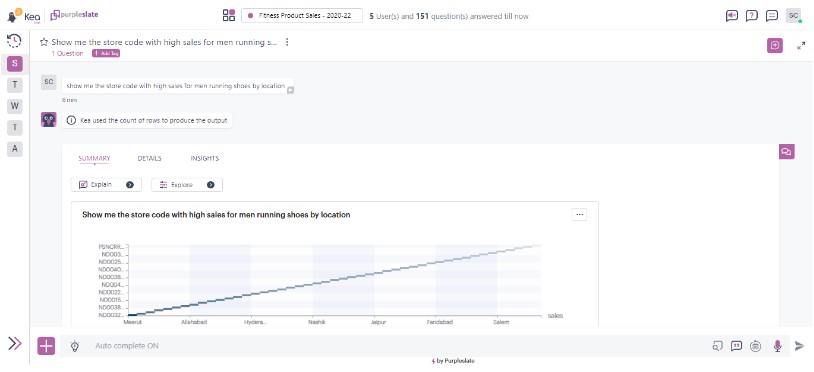
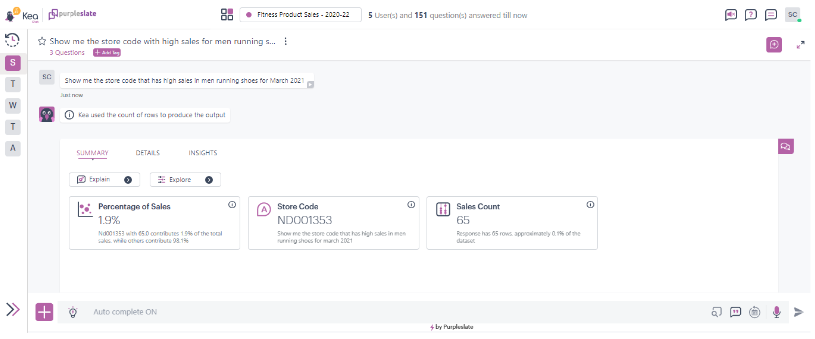
Comeback: Rakesh asks the franchise owner to increase his order number by 25% as the intercollegiate athletic meet will happen in the next season with many colleges participating. Along with the regular customers, Rakesh is sure that walk-ins will also increase on account of this event.
Scenario – 2: Many times when Rakesh comes in for a discussion with his region’s franchise owners they have two recurring complaints. One is that since the introduction of e-commerce websites, many of their sales have gone down for Rakesh’s brand. This is because most customers prefer buying directly online to get better discounts. The second complaint is that since there are company owned company operated outlets within a 5 Km radius for some major franchisees, their footfall has gone down significantly. Thus they wanted to order 20% less as opposed to the usual. They claim that Rakesh, the brand manager, prefers pushing more customers there. Rakesh wanted to quell the doubts once and for all.
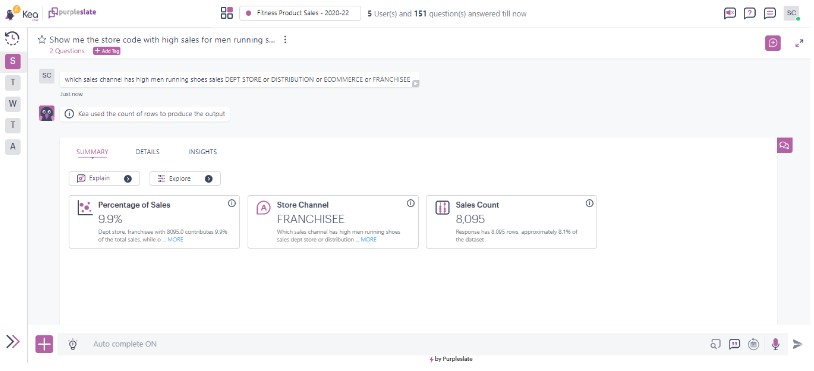
Comeback: Rakesh points out that out of 4 major channels – Dept stores, Distribution (Company owned company operated outlets), Franchise, and E-commerce, Franchise has the highest sales. Because Franchise gives the touch and buys feel that e-commerce lacks, the service is far better than company outlets. Also, the franchise outlets are located in prime areas with more footfall as opposed to company outlets that serve as a secondary stores in case the required product is unavailable in the franchise or as a channel to push End-of-Season or Going-out-of-business style sales. Thus they should not bring their order numbers down.
Scenario – 3: A store wanted to run a specialized campaign for Running in September and wanted to order 15% more shoes than the fixed target. It was confident of the result of the campaign and was almost on the verge of convincing Rakesh. But Rakesh, a data-driven brand manager, quickly checked the sales numbers for September and was astonished to see that only five running shoes were sold that month. The sales had gone down by 44%.
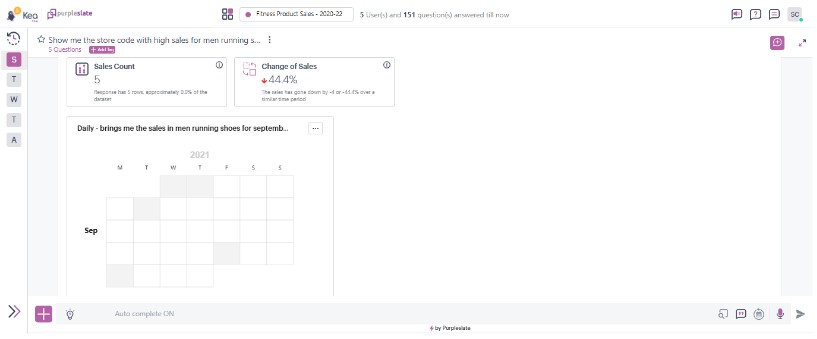
Comeback: Rakesh showed the number to the franchise and explained why they cannot rely on September to increase running shoe sales. September is considered part of an on-and-off monsoon season in that franchise’s region, and the rains, even though sporadic, are heavy. Thus, increasing the order numbers to sell in September will impact their full-price sell-through and will end up as heavily discounted sales. Thus, it’s better to move the campaign to November when a marathon is planned to support cancer awareness.
Scenario – 4: Rakesh’s boss Ranjan was at the meeting where he was talking to his Franchise owners and ordering shoes for FW season. Ranjan wanted to increase the order numbers by another 10% per franchise given the number of activities being planned around the region. He pulled Rakesh aside and told him that he needed this increase in the target number no matter what. Rakesh tried many times to convince Ranjan that it would be futile and that the shoes would go for discount sales. But Ranjan being a bull-headed boss was not at all listening to Rakesh.
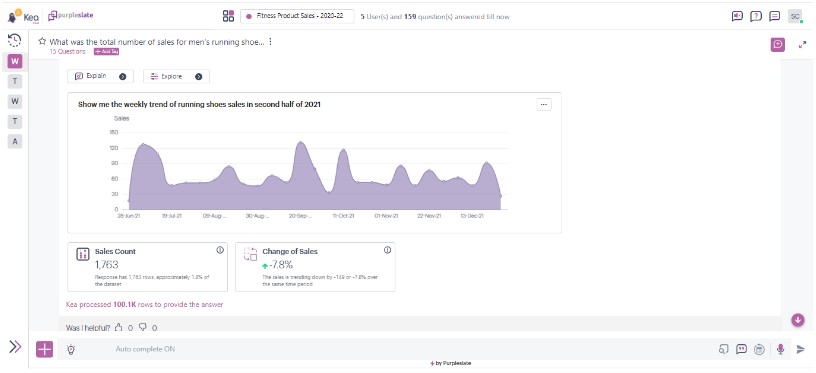
Comeback: Rakesh showed the weekly running shoe trend for the last year and talked to Ranjan. He said there was no clear spike in sales throughout the week and this trend was true for the entire second half of the year. This has been the case for a few years now because of various reasons ranging from hostile takeover of franchises by competitors to unforeseen cancellation of running events. Most of them are not in the control of the brand team, and if Ranjan still wants to increase the order number, there is a high chance that franchises will demand a 10% cut down on the order numbers the following year.
Kea – Simplifying Information Access
Kea helped Rakesh instantaneously access information. Previously, Rakesh used to fidget with his spreadsheet to get the same answers, and he had zero time to prepare for a counter strategy. This time was different because Rakesh got all the answers right and his order numbers were as close to perfect as possible. The retailers were happy that Rakesh’s order numbers helped them gain better margins and that Rakesh could expand his network of franchises based on their recommendations.
Imagine as a sports retail brand or sales manager if you’re able to be like Rakesh. Get answers immediately. Plan well in advance for your next meeting with your franchise network owners. And walk back with a fat commission for a successful autumn-winter sale.
This is where Kea’s true power lies. It empowers you to make the right decisions without ever doubting yourself. Simply, you just plan your order numbers and targets to be achieved. Let Kea worry about fetching the right information for you at the right time.
Want to know more about Kea? How about you get in touch with us, and we will let you feel the real power of Kea with a small demo?




